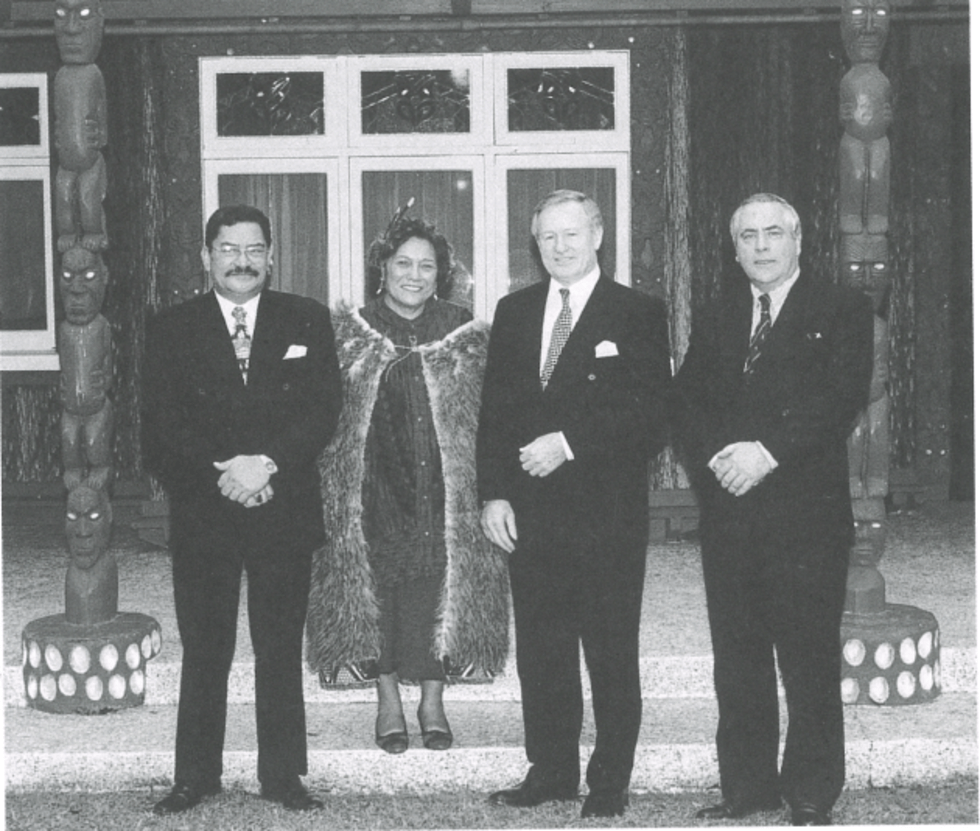SIR ROBERT MAHUTA
BUSINESS HALL OF FAME
Inducted 2022 (posthumous)
Watch the citation read by Ezra Hirawani and the acceptance speech by Sir Robert's daughter, Hon Nanaia Mahuta, here.
Citation
Sir Robert Te Kotahitanga-a-Koeoki Mahuta was born in 1939 in Te Kuiti.
At four weeks old he was adopted by the fifth Māori King, Koroki and his wife Te Atairangikaahu.
Sir Robert grew up at Waahi Pa in Huntly, under the watchful eye of his great aunt, Te Puea Herangi – the Kingitangi leader.
Education played a prominent role throughout Sir Robert’s life, although at times it was a love / hate relationship. Despite his father wanting him to become a mechanic, Te Puea had higher aspirations for him and was determined to ensure he lived up to them. From the age of six onwards he would be expected to read the local paper to his mother and father. While the other children played outside Sir Robert would be inside, informing the elders about the happenings of the wider world. At an early age his mischievous side emerged so if he couldn’t quite understand the words, Sir Robert made up stories about what was going on!
Later, he was enrolled at Mt Albert Grammar in Auckland, an experience that he would later say was quite traumatic. Sir Robert could be stubborn at times and was determined to do things his way. His disillusionment with school in his teenage years caused him to drop out and work a variety of manual labour jobs, including the mines, wharves, and freezing works, and even doing a stint overseas with the Army before being discharged to Dunedin. It was there Sir Robert met his wife, the late Lady Raiha Mahuta, and, inspired by her success at school, enrolled himself in a night school to complete his School Certificate.
Sir Robert achieved that, surprising himself with his good marks, and applied for a degree in Anthropology at Auckland University the following year.
He would go on to complete his Masters, and travel to Oxford University in the UK to study for his Doctorate. He never quite got around to finishing his Doctorate; the needs of his people were paramount and drew him back to his country, but he always said he appreciated the work he invested into it as it provided him with the theoretical background to approach many of the problems he would deal with later on in life. His time at Oxford would form the inspiration for the Endowed College in Hopuhopu, the powerhouse of tribal strategic thinking and critique. Sir Robert’s legacy is kept alive through the next-generation of leaders graduating from the College today, as well as the University of Waikato where he was the founding Director of the Centre of Māori Studies.
Sir Robert’s adopted sister was the late Dame Te Atairangikaahu and the two of them were quite close, despite growing up independently and separately. When Dame Te Ata initially succeeded her father, their relationship became strained, because they had different ideas on which direction the Kīngitanga should take. Sir Robert believed she wanted to take it in a much more Pākehā way while he wanted to stick closer to their Māori side, and the Māori principles in which the movement was founded. Thankfully their paths merged, and both settled into more comfortable leadership roles – Dame Te Ata as the ceremonial leader and Sir Robert as the fixer. The combined leadership of the two siblings would help guide Tainui through periods of momentous change.
He wasn’t entirely sure when the spirit of transformation and activism entered him, but Sir Robert’s first foray into iwi politics concerned the 1946 settlement claim between his Aunt Te Puea and Peter Fraser, the Prime Minister of the time.
When he wanted to renegotiate the settlement, Sir Robert found himself clashing with the elders of the Tainui Māori Trust Board who viewed it as countering her achievements. This wasn’t the case at all; Sir Robert simply knew it had been the best deal available at the time, but times had changed, and inflation alone meant the original settlement deal had devalued by up to 50%. So, ignoring the naysayers, Sir Robert marched on down to Wellington and demanded a better deal.
His force of will and powers of persuasion were successful in securing a promise from Duncan MacIntrye, the Deputy Prime Minister of the day, that for every dollar Tainui put into investment properties in Hamilton, the Government would match it with two dollars. A pretty good return for the times.
Unfortunately, the elder members of the Tainui Māori Trust Board were vehemently opposed to the proposed deal, seeing it as a dishonour to Te Puea, causing the deal to fall through. This experience would be invaluable to Sir Robert later on and help form his philosophy of business.
He was always a big believer in trusting his people. When Te Ata succeeded the throne and was looking for a project to make her mark, the idea of building a brand new dining hall at Tūrangawaewae in honour of Te Puea resurfaced.
Te Ata asked Sir Robert if he would take charge of the project and he agreed but essentially said it would be done his way or he wasn’t doing it. Everyone agreed and promised to let him take the helm, which worked out fine until the project was costed at $750,000, a huge amount at the time.
Everyone argued that first they should fundraise the money, then build it. Not Sir Robert. He knew that if they took a loan and built it first, and then asked the people to fundraise, it would get done. By trusting his people and giving them something real to touch and experience, he knew they would come together to meet the challenge. And they did. Banding together in one great effort they managed to raise the required funds, and open Kimiora whare kai free of debt. Today it still stands as one the more historical buildings in all of Māoridom.
In 1972 Sir Robert was appointed Director of the Centre of Māori Studies at Waikato University and is directly responsible for the program being what it is today, with a focus on action research.
Sir Robert was a practical man and truly believed in living life out amongst his people, not hiding away in a library, although he loved nothing more than a good book. In 1983 he co-wrote the Tainui Report, along with his friend Ken Egan, which was a first for Māori. The report allowed Tainui to begin to see a path forward, to the future they wished to create for themselves, and Sir Robert met with many young leaders from iwi around Aotearoa and taught them to do the same.
It was during the CoalCorp debate in the late 1980’s that Sir Robert saw the opportunity for real change to occur, a catalyst for progress in the raupatu settlement claim. After the Court of Appeal ruled that the Crown must listen to and work with their Treaty partner, Sir Robert saw that it was time for the real negotiations to begin. The Crown wanted the coal, the iwi demanded raupatu and Sir Robert was going to make sure they received it.
Muldoon’s National Government made the initial approaches to no success, then Lange’s Labour Government came in and tried their best to wriggle out of the Court of Appeal’s ruling, but Sir Robert would not back down. When National got back into power in 1990 with Jim Bolger at the helm the climate had become much more receptive, and negotiations could truly begin.
Sir Robert and his team travelled to Wellington on a monthly basis, to hash out the terms of the settlement with the Minister of Justice at the time, Doug Graham. After a few months of this an exasperated Doug asked him to quit horsing around and put some numbers to the negotiation. Stubborn Sir Robert would simply counter with “there are no numbers, it’s just that land was taken and so land should be returned, now you think about that Doug and how you’re going to achieve it.”
Eventually the figure of $170 million was offered, in cash and assets, provided Waikato-Tainui released their claim to the coal. Sir Robert countered with “well okay provided you pay interest immediately and we remain the first cab off the block with no other claim being more than the total awarded to us.” Doug Graham and Jim Bolger agreed and finally, after decades of debates and negotiations, a raupatu settlement was reached.
The historic Deed of Settlement was signed in 1995 at Tūrangawaewae by Dame Te Ata and Prime Minister Jim Bolger. It would be the first of many raupatu reparations by the Crown to Tangata Whenua and included a formal apology from the Crown, a first for any indigenous people who suffered injustices by the British Empire.
Queen Elizabeth gave the Royal assent to the subsequent Waikato Raupatu Claims Settlement Act with Te Ata and Waikato kaumaatua. It was the first time a British Monarch had ever apologised to Maori, and is still the only piece of legislation signed in New Zealand and in public by the Queen.
Sir Robert took a backseat to the business of the iwi after this, preferring to let new blood and fresh faces tackle the challenges of tomorrow.
In June 1996 he became the first person to be appointed a Knight Companion of the New Zealand Order of Merit (KNZM) in recognition of his services to Maaori people. Sir Robert was invested with the knighthood in May 1997 at Tuurangawaewae.
He sadly passed away on February 1st, 2001, at the age of 61.
Sir Robert was a transformational leader, one whose legacy has forever shaped the direction of our country.
He believed there are two qualities that every great leader must possess.
The first is accountability. Accountability to the people that trust you to lead them, and to deliver on your promises to them. He believed you should not need outside experts to come in and tell your people that you have acted in their best interests; they should be able to see that clearly for themselves.
The second is vision; possessing a clear vision of the future, one that is beneficial for all but tied to the ability to develop and implement a plan that will bring that future about.
We are deeply honoured to be inducting Sir Robert into the Waikato Business Hall of Fame this evening. We want to leave you with a quote from him, one that encapsulates the kind of man he was and his viewpoint of the world.
“In one sense all that we have to offer future generations is the past.
Containing as it does the hopes, the spirit and determination of the people,
Their constant example, both of virtue and of error.
But what a treasure chest that really is.
That is brightness enough to guide the way ahead.”


















